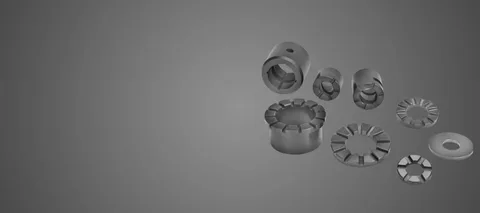In demanding industrial settings, bearings must endure heat, friction, and corrosion while supporting moving parts. Graphite stands out for its self-lubrication, heat resistance, and chemical durability—making it a reliable choice where metals or polymers often fail.
What Are Graphite Bearing Materials?
Graphite bearing materials are carbon-based components used in bushings and bearings. They are made from pure graphite or composites with resins or metals for added strength or conductivity. Their layered structure provides natural lubricity, enabling smooth, lubricant-free operation—ideal for high-heat or hard-to-reach environments.
Key Properties of Graphite Bearing Materials
-
Self-Lubricating
The most defining feature of graphite bearing materials is their self-lubricating nature. During operation, graphite releases fine particles that form a low-friction layer between contact surfaces. This quality ensures continuous, smooth motion even in dry-running or vacuum conditions, significantly reducing maintenance needs.
-
High Thermal Resistance
Graphite can tolerate extremely high operating temperatures—often above 500°C (932°F)—without degrading. This makes it suitable for high-temperature applications like furnaces, ovens, turbines, and engine systems where other materials would soften, melt, or oxidize.
-
Chemical and Corrosion Resistance
Graphite is chemically inert and corrosion-resistant, unlike many metals that corrode in acidic or caustic environments. This property makes graphite bearing materials a top choice in chemical processing, wastewater treatment, and food production industries where harsh chemicals are present.
-
Dimensional Stability
Graphite materials maintain their size and shape across various operating conditions. Their low thermal expansion and resistance to moisture absorption make them ideal for precision components requiring consistent performance.
-
Electrical Conductivity
Graphite also exhibits high electrical conductivity. While this is a disadvantage in some insulating applications, graphite is suitable for electro-mechanical components and electrical motor brushes.
Types of Graphite Bearing Materials
Graphite bearing materials come in various forms, each tailored to specific performance needs:
- Pure Graphite: Offers excellent thermal and chemical resistance but can be brittle under impact or shock loads.
- Impregnated Graphite: Infused with resins, waxes, or metals to improve strength, reduce porosity, and enhance lubricating performance.
- Resin-Bonded Graphite: Combines graphite powder with resin binders in lower-temperature, moisture-sensitive environments.
- Metal-Graphite Composites: Blend metal durability with graphite’s self-lubrication. Often used in high-load, moderate-temperature environments.
Common Applications of Graphite Bearings
Graphite bearing materials are used across industries where durability, reliability, and low maintenance are critical. Common applications include aerospace components like jet engines and actuators, automotive systems such as water pumps and exhaust fans, and chemical processing equipment exposed to corrosive fluids. They’re also found in power generation turbines, food-grade machinery requiring lubricant-free operation, and heavy-duty equipment in metallurgy and foundries.
Advantages Over Traditional Materials
Compared to conventional bearing materials such as bronze, steel, or plastics, graphite bearing materials offer several advantages:
- No lubrication required, reducing maintenance and environmental concerns
- Operation at extreme temperatures, well beyond the range of most metals and polymers
- Longer service life in corrosive or abrasive environments
- Lower coefficient of friction, reducing energy consumption and mechanical wear
- Reliable performance in environments with poor or no lubrication support
These features make graphite the go-to material in applications where uptime, reliability, and operational safety are non-negotiable.
Installation and Maintenance Tips
Graphite bearings are easy to install, typically requiring only a light hand fit. Proper alignment is essential to prevent uneven wear, and care should be taken to avoid impact—especially with brittle pure graphite. Maintenance is minimal, with occasional inspections for wear or cracks. In dusty environments, sealing the housing may be necessary. With proper setup, graphite bearings offer long-lasting, low-maintenance performance.
Limitations to Consider
Despite their advantages, graphite bearings have some drawbacks. Pure graphite is brittle and may crack under impact. Load capacity can be limited unless reinforced with metals or resins. While the initial cost may be higher, long-term savings in maintenance and longevity often make up for it. Assess application needs carefully to ensure graphite is the right choice.
Looking for a Better Bearing Solution?
In extreme conditions, graphite bearing materials offer unmatched reliability, self-lubrication, heat resistance, and chemical durability. Ideal for industries from aerospace to chemical processing, they reduce maintenance, extend equipment life, and boost efficiency—making them a smart, long-term investment.
Explore how graphite bearings can improve your operations. Contact us today to find the right material for your application.

